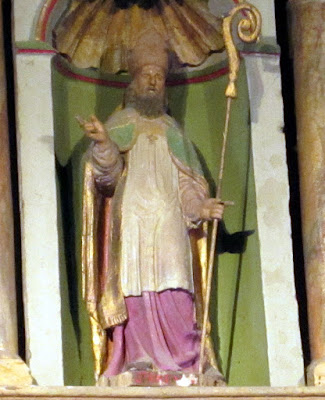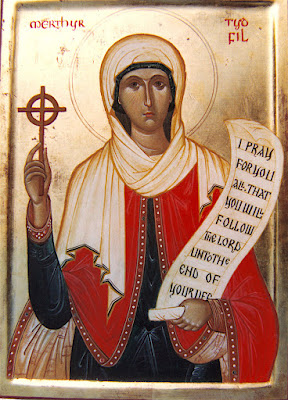The very last day on our liturgical calendar in the Orthodox Church also happens to be the feast-day of Holy Father Aidan [Aedán, Aodhán], Irish monk of Iona, founder and first bishop of the Holy Isle of Lindisfarne, close friend of Saint Óswald King of Northumbria, one of the first and greatest fathers of English Christianity, and an apostle particularly to the English North.
As with sadly all too many early saints of the British Isles, practically nothing is known of Saint Aidan’s birth, parentage, circumstances or early life. We know from Bede the Venerable that he was a monk at Hii (that is to say, the monastery of Saint Columba at Iona) from an early age. We also know certain things about his character as a monk. Bede describes him as ‘a man of outstanding gentleness, holiness and moderation, zealous in God’s cause’. Aidan was, for example, strict in great degree with himself: with the blessing of his abbot and in accordance with his bodily strength, he undertook a severe fasting régimen, mortification and other forms of abscess. But he was also in the same degree mild and sweet with his brothers and with all non-monastics, forgiving and understanding of weaknesses.
Saint Óswald spent much of his time in exile at Iona. It is therefore not improbable that Aidan was well and intimately known to the exiled prince. All the same, when Óswald returned to take the throne in Northumbria and sent for a teacher in Christianity from Iona, Aidan was not the first man they sent. Instead another monk, Cormán, went. Equal to Aidan in ascetic austerity but somewhat lacking in grace, Cormán found to his horror that the heathen English of the North were given to all manner of vices: violence, drunkenness, fornication, superstition. He denounced English sinfulness in strident terms. When they refused to listen and complained of him, the frustrated monk returned to St Columba’s. When asked the reasons for his return, Cormán said to the abbot that ‘they were an uncivilised people of an obstinate and barbarous temperament’. Hearing this, Saint Aidan gently rebuked his brother Cormán:
Brother, it seems to me that you were too severe on your ignorant hearers. You should have followed the practice of the Apostles, and begun by giving them the milk of simpler teaching, and gradually instructed them in the word of God until they were capable of greater perfection and able to follow the sublime precepts of Christ.The monastic brothers of Iona agreed thereon that Aidan be sent instead as a missionary bishop, and the monk agreed to go. Upon his arrival in 635, Saint Aidan asked of Óswald, and was given, the isle of Lindisfarne on which to build a monastery. The isle was fitting for two reasons: it was near to Óswald’s main holding at Bamburgh; and though it was a secluded island at high tide, at low tide a sandbar joined the isle to the mainland, allowing passage across. Aidan, an Irishman who spoke little English, went afoot among the English, often with the king himself as his interpreter. He spoke to the folk on their own level, not scolding or hectoring or using highfalutin theological terms, but gently teaching using tactile images and words they could grasp with ease.
Saint Aidan, though he held to the Celtic rite (much to Saint Bede’s legible chagrin) and was not part of the Gregorian mission, shared the Pope’s love for the English folk, especially the poor. He set no store by wealth or goods. Whenever some rich man gave him a gift, he sold it and gave the proceeds away to the needy, or else used the money to redeem slaves from their captivity. Much like the Serbian Patriarch Pavle of blessed memory in more recent times, Saint Aidan did not like using ostentatious or comfortable forms of transportation, but preferred to go on foot. Saint Aidan was once given a fine horse by Óswald’s successor, Saint Óswine of Deira, but upon first seeing a beggar in need, he took the horse along with all its kingly trappings and gave it to the beggar. Óswine asked why he had done this with his gift, and Saint Aidan replied thus: ‘What are you saying, Your Majesty? Is this foal of a mare more valuable to you than this child of God?’ Being thus mildly rebuked, Óswine took his sword and knelt before the bishop, swearing never again to speak of the horse, nor to judge the bishop for whatever he gave to the poor.
Holy Father Aidan was also remarkable for his keen foresight and for the power of his prayers. He was once approached by a certain priest named Utta, who was bound abroad to bring back a maiden named Éanflæd, who had been exiled to Kent on the death of her father Éadwine, as a bride for Óswíu King of Northumbria. He was bound for Kent by sea and first went to Aidan to get his blessing. Aidan gave it, and also gave to Utta a phial of holy chrism, and told him to sprinkle it on the waters if any inclement weather should arise. Arise it did, in a terrible way. The sailors tried to lay anchor to weather the storm, but the line broke. The shipmen panicked as their ship was tossed about and water began to break over the hull. The ship was threatening to sink, and the shipmen became convinced that all their deaths were at hand. But Utta managed to grab the phial and emptied its hallowed contents out into the chopping, churning waters. No sooner was this done than the storm calmed and the sea became still. Thus Aidan through the foresight given to him by God saved the lives of Utta and Éanflæd, and the wedding of Óswíu with Éanflæd went forward. (She would later retire to Whitby Abbey and would serve there as abbess; and one of the fruits of her union with Óswíu was the future holy mother Ælfflæd of Whitby.)
Saint Aidan is known, and not without grounds, as a particular patron of firefighters. Much like Holy Hierarch Mellitus did in Canterbury, Saint Aidan saved Bamburgh from a fire set by the fell heathen king, Penda of Mercia. Penda had laid waste to all the hamlets in the surrounding countryside, and sought to bring a swift end to the siege. He brought brush, dry straw, planks and beams with him and laid them about the city walls, setting them on fire. Saint Aidan, who sat at prayer on the Isle of Farne two miles off, saw the conflagration and called out, ‘Lord, see what evil Penda does!’ No sooner were these words uttered but the winds shifted and blew southward, turning the flames back upon the town’s besiegers. The siege was indeed lifted, because Penda’s marauding Mercians drew away frightened. By this omen they understood Bamburgh to be a holy stead, shielded by divine power.
Saint Aidan served as Bishop of Lindisfarne for sixteen years. Aidan liked to preach and pray in a small kirk nearby the town of Bamburgh, and he did so until the end of his earthly life. The deacons had set up a teld outside the kirk by its west wall, in which Saint Aidan could still pray even when sick. As it happened, he leaned against one of the posts of the kirk when he reposed, on the thirty-first of August, 651. He was taken back to Lindisfarne and buried in a state of honour in the churchyard there, where he was succeeded by Saint Finan of Lindisfarne, the second abbot-bishop there. It so happened the kirk on the mainland where Saint Aidan had rested and died later was burned to the ground by Penda’s heathen Mercians: wondrously, the only thing in that kirk left standing was the post on which Saint Aidan had been leaning at the end of his life. That post, which served as part of the structure in three subsequent churches, became a site of pilgrimage and a wonder-working relic in its own right, its hallowed wood healing many who came there to visit.
Saint Bede has a certain tendency (not unknown to English historians of any age, really) to write a bit stuffily and haughtily about his ideological opponents. In his case, that would be anyone connected with the Celtic-Roman Easter controversy on what was actually the wrong side. At the same time, thankfully, as a historian, Bede’s scholarly scruples and genuine humility outweighed his polemical tendencies. Saint Bede, even as he reproved in the harshest terms Saint Aidan’s error regarding the calendar, had nothing but sincere praise for Aidan:
He cultivated peace and love, purity and humility; he was above anger and greed, and despised pride and conceit; he set himself to keep and to teach the laws of God, and was diligent in study and prayer. He used his priestly authority to check the proud and powerful; he tenderly comforted the sick; he relieved and protected the poor.And so also we should remember this most remarkable and beautiful-souled Irish saint of our Church, who went a missionary into unkith lands not with a quick tongue, bravado or vainglory, but instead with a heart full of love. He preached the Gospel not only in words, but also in his help to the unfortunate and his consolation to the sorrowful. Holy Father Aidan, humble friend of the poor and downtrodden, calmer of the storms of our worldly cares and douser of the fires of Hell, pray unto Christ our God that our souls may be saved!
A scion of Ireland, transplanted to Iona, the isle of saints,
Tended there thou didst grow to spiritual fruition;
And when the field of Northumbria
Was ready to receive the seeds of the Christian Faith,
Thou wast sent thither to plant the crop of salvation.
Wherefore, labouring diligently day and night,
Thou didst produce a rich harvest for Christ.
O godly Aidan our father, entreat Him earnestly, that our souls find mercy.


























